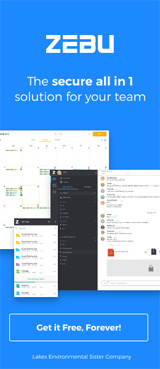Lakes Environmental Newsletter
In this issue:
- News & Events
- Upcoming Courses
- Modeling Tip: Sensitive Receptor Summary Report in CALPUFF View
- Articles
- Upcoming Conferences & Trade Shows
News & Events
Prognostic Met Data Webinar Held Nov 15, 2018
|
A special thank you goes out to all those who registered and logged in to our 30-minute webinar presentation focusing on obtaining met data from prognostic models using regulatory approved methods. We hope that you found the webinar helpful and that the provided information will enable you to make the most knowledgeable decisions possible for your future environmental air quality project needs. For upcoming webinars, please be sure to check out our webinar schedule online. |
Lakes Environmental December Holiday Schedule
Please find below the holiday schedule for Lakes Environmental’s offices:
December 17-21 |
Open |
December 24 |
Closed |
December 25 |
Closed |
December 26 |
Closed |
December 27-28 |
Open |
December 31 |
Closed |
January 1 |
Closed |
If you have an urgent matter requiring assistance during the holidays, please e-mail us at support@webLakes.com and we will respond to your inquiry during regular business hours.
AERMOD and CALPUFF Courses in Dallas, Texas – Feb 18-21, 2019
|
Lakes Environmental will kick off their 2019 training schedule with 4 days of AERMOD and CALPUFF training in Dallas, Texas from February 18 to 21, 2019. CALPUFF attendees will have the opportunity to complete a Do It Yourself Case Study using WRF processed data for a location of their choice making this course of great benefit to their modeling work. Early registration discounts are available until January 4, 2019. Register now!
|
AERMOD Course in Toronto – Feb 25-26, 2019
|
Lakes Environmental will present a 2-day AERMOD course in Toronto from February 25-26, 2019. This course will feature a special section and case study regarding the dispersion modeling requirements of Ontario Regulation 419/05: Air Pollution - Local Air Quality. Register online today to take advantage of our early registration discount! Early Registration Discount Ends: January 14, 2019
|
AERMOD and CALPUFF Courses in Las Vegas – May 6-9, 2019
|
Lakes Environmental will host 4 days of AERMOD and CALPUFF training in Las Vegas from May 6 to 9, 2019. The CALPUFF portion of this course will include a special Class I Area Visibility case study and WRF case study for each student’s desired location. Register now to take advantage of our early registration ending March 22, 2019.
|
AERMOD Course in London, UK – May 27-28, 2019
|
Lakes Environmental will be in London to present a 2-day AERMOD course from May 27-28, 2019. You only have until March 27, 2019 to take advantage of our Early Registration Discount. Register online now!
|
Upcoming Courses
Date |
Course |
Location |
Registration |
Feb 18-19, 2019 |
|||
Feb 25-26, 2019 |
|||
May 6-7, 2019 |
|||
May 27-28, 2019 |
For more information on the above courses, including registration information, location, and course outlines, please visit our web site: https://www.weblakes.com/courses.html.
Modeling Tip
Sensitive Receptor Summary Report in CALPUFF View
When conducting an air quality modeling analysis, you may be called on to compute concentrations at sensitive receptors. While specific definitions of sensitive receptors vary from one jurisdiction to the next, it most commonly refers to receptors used in a modeling analysis to represent a sensitive population. Examples include schools, daycare facilities, hospitals, care facilities, and more.
The latest update to CALPUFF View (Version 8.6) includes the ability to flag discrete receptors as ‘sensitive’ and have their results compiled into a Sensitive Receptor Summary Report.
Follow the steps below to use the sensitive receptor function:
- Go to the Receptor button on the Toolbar and select Discrete Receptors
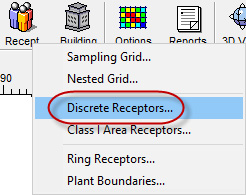
- Use the table and Preview panel to place or identify discrete receptors of interest. Place a checkmark in the Sensitive column to flag the receptor for inclusion in the report. Consider adding a Description to add detail to the selected receptors as that information is carried over to the Sensitive Receptor Summary Report.
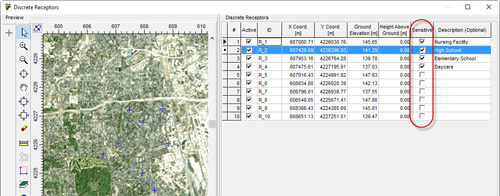
- Complete your CALPUFF modeling analysis as usual.
- In the CALPOST Wizard, go to the Run Info tab and check your Receptor selections. If you only want to process a subset of Discrete receptors, click the Select Discrete Subset button, and use the dialog to select which receptors you want to process. Those flagged as Sensitive are noted in the Specify Receptors to Process.
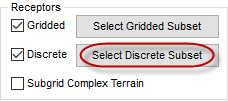
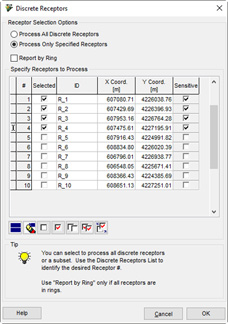
- Run CALPOST to complete processing.
- Select the Reports Toolbar button.

- Select the Sensitive Receptors summary report. The Advanced Filter allows you to sort which Pollutants are displayed in the report.
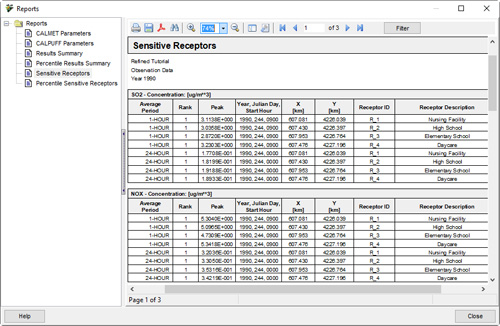
Results in the report are sorted by pollutant, averaging period, and rank. Receptor coordinates, ID, and description are also included. A separate Percentile Sensitive Receptors report is available to summarize percentile results.
Submit Your Modeling Tips Today!
We are currently accepting submissions for the Monthly Modeling Tip section that appears in our newsletters. If you have a modeling tip that may benefit our readers, please send it to us at support@webLakes.com. Your name and the name of your organization will appear below the tip providing you with an opportunity for increased exposure.
Articles
WWF Report Reveals Staggering Extent of Human Impact on Planet
October 31, 2018 - Humanity and the way we feed, fuel and finance our societies and economies is pushing nature and the services that power and sustain us to the brink, according to WWF’s Living Planet Report 2018. The report presents a sobering picture of the impact of human activity on the world’s wildlife, forests, oceans, rivers and climate, underlining the rapidly closing window for action and the urgent need for the global community to collectively rethink and redefine how we value, protect and restore nature.
The Living Planet Report 2018 presents a comprehensive overview of the state of our natural world, through multiple indicators including the Living Planet Index (LPI), which examines trends in global wildlife abundance. Tracking 16,704 populations of 4,005 vertebrate species, the LPI finds that global populations of mammals, birds, fish, reptiles, and amphibians have declined, on average, by 60 percent between 1970 and 2014, the most recent year with available data.
Reducing Methane Emissions Can Play a Key-Role in Reducing Ozone Worldwide
October 30, 2018 - Methane is a climate pollutant that leads to the production of ozone with serious health and environmental impacts.
60% of all methane emissions originate from the energy, waste and agriculture sectors.
Targeting these three sectors with methane reduction policies can lead to significant reductions in overall methane emissions.
Location of Large ‘Mystery’ Source of Banned Ozone Depleting Substance Uncovered
October 26, 2018 - The compound, carbon tetrachloride, contributes to the destruction of the Earth’s ozone layer, which protects us from harmful ultraviolet radiation.
As a result, the production of carbon tetrachloride has been banned throughout the world since 2010 for uses that will result in its release to the atmosphere. However, recent studies have shown that global emissions have not declined as expected, with about 40,000 tonnes still being emitted each year.
The origin of these emissions has puzzled researchers for many years.
US Air Pollution Deaths Nearly Halved Between 1990 and 2010
October 22, 2018 - Air pollution in the U.S. has decreased since about 1990, and a new study conducted at the University of North Carolina at Chapel Hill now shows that this air quality improvement has brought substantial public health benefits. The study, published Oct 19 in the journal Atmospheric Chemistry and Physics, found that deaths related to air pollution were nearly halved between 1990 and 2010.
The team’s analyses showed that deaths related to air pollution exposure in the U.S. decreased by about 47 percent, dropping from about 135,000 deaths in 1990 to 71,000 in 2010
For additional environmental news, visit the Environmental News Network (ENN), the most
dependable online environmental news source!

Upcoming Conferences & Trade Shows
Nov 21-22, 2018 |
International Conference on Environmental Technology and Innovations (ICETI 2018) |
Prague, Czech Republic |
Dec 6-8, 2018 |
6th International Conference on Environment Pollution and Prevention (ICEPP 2018) |
Brisbane, Australia |
Jan 3-5, 2019 |
The IAFOR International Conference on Sustainability, Energy & the Environment – Hawaii 2019 |
Honolulu, HI, USA |
Jan 14-17, 2019 |
World Future Energy Summit |
Abu Dhabi, UAE |
Feb 13-15, 2019 |
10th International Conference on Environmental Science and Development |
Milan, Italy |
Feb 25-27, 2019 |
22nd EUEC 2019: Energy, Utility & Environment Conference |
San Diego, CA, USA |
Mar 19-21, 2019 |
AWMA 8th Specialty Conference on Air Quality Models |
Durham, NC, USA |
Mar 26-28, 2019 |
AMERICANA 2019 |
Montréal, QC, Canada |
May 7-9, 2019 |
Canadian Environmental Conference and Tradeshow (CANECT) 2019 |
Vaughan, ON, Canada |
Jun 25-28, 2019 |
AWMA 112th Annual Conference & Exhibition |
Québec City, QC, Canada |
About this Newsletter
This newsletter contains information gleaned from various sources on the web, with complete links to the sources cited. Organizations cited are in no way affiliated with Lakes Environmental Software.
Lakes Environmental Software is a leading environmental IT company that offers a complete line of air dispersion modeling, risk assessment, emissions inventory, and emergency release software as well as training and custom software services. With satisfied users located around the globe, Lakes Environmental Software will continue to revolutionize the environmental software field.
For more information please visit our web site at: www.webLakes.com. You may also contact us by phone at (519) 746-5995.
All comments and suggestions are welcome. You can e-mail us at: support@webLakes.com.







